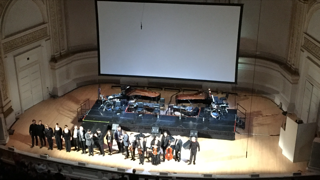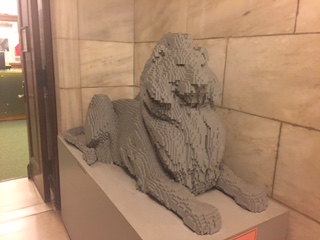I asked specifically about circular breathing and how to apply the bubble-blowing exercise to the flute. Robert encouraged trying to jump straight from bubbles to flute, so that’s how we spent the beginning of class. I had a couple of almost successful tries maintaining a (very rough) sound while circular breathing. Robert’s suggestion was to begin with the embouchure for soft dynamics, since this will allow the air more time to travel as it’s pushed out of the cheeks. We tried it in a few different registers. Playing a third-octave note gives more resistance, which is the most like the bubbles through the straw exercise. So, here’s to continuing this journey.
I’m borrowing one of Robert’s bass flutes for a piece I’m playing in our final recital. He said to keep the flute low on the face, which has helped tremendously. My biggest challenge with the bass flute currently is having the hand strength to hold it up long enough to practice, heh heh.
We again visited the Karg-Elert op. 107 Studies. We started with no. 22, which we sang through bits of in our last class. As he’s said before, Robert told us to turn up the volume of the singing in our head when approaching “trouble” passages. We talked about hand position again, and Robert brought out his opposite flute. Holding a flute to the other side demands a better awareness of hand position since everything feels so foreign. My brain about melted out of my ears just trying to hold the dang thing.
No. 23 of the Karg-Elert Studies was the next focus. Jenn played while Robert taught and I “coached”, aka I asked maybe two questions for Jenn to consider. Robert thinks no. 23 is akin to Italian opera with tons of drama and passion. Rolling with that idea, it’s important to establish a few things: Who is singing? Who are they singing to? What are they singing about? Robert said, “As long as you are feeling what it means to you, the audience will feel what it means to them.” Boom.
And then the moment I’ve been wanting for years! We started really working on Voice by Takemitsu. We had talked about it earlier in the semester, but we actually starting digging into it more. Because this piece is basically a ghost story, Robert suggested thinking of the most terrifying feeling we could remember. He mentioned the Japanese mythology of Hoichi the Earless; a version of this folk ghost story appears in the film Kwaidan (around the 1 hour mark), which I’m watching in bits to help establish a basis for Takemitsu’s piece. I generally stay away from scary things, so we’ll see how this goes.
Robert has said the hardest part about Voice is the acting component. Right now, however, the hardest part for me is becoming familiar with the notation. But it’s exciting to experiment a lot with sound as we’re learning the piece. If a major goal is to create “other worldly” sounds, that provides quite a bit of room to figure out what works best. One of the markings indicates vocal involvement while playing. Takemitsu himself explained to Robert that he imagined this vocal sound as a grunt, as is done by shakuhachi players. Originally Robert had prepared these parts with singing the indicated pitch; since female players generally do not create the same type of grunt Takemitsu had in mind, singing and playing is a viable alternative. The fun part is that the indicated pitch in the score is not actually a pitch, so you can find what combination of singing and playing results in the craziest sound. For me personally, singing a tritone below a played note created some really crazy difference tones and sonorities. I think this process also helps make the piece your own. Another important aspect is to identify the characters of the piece (I’m choosing myself and a ghost), what the piece is (a narrative of an event), and who is talking when. I made myself a chart of the character changes for the first page. This exercise also helped me notice patterns and motives and use them to make informed decisions. Yay music making!
We ended class by talking about flute designers and makers. There’s actually a program where you can make your own flute. I don’t have the funds for it, but it sounds pretty legit. It would be AMAZING to try out new designs for the fingering systems though. Robert has done this a few times, and besides the flute looking awesomely crazy, it’s a great way to better empathize with beginner students and to also question if there’s a better way to do things than what’s always been accepted. It’s almost like the ACU difference #exceptional #innovative #real
Other things:
- Sarah and I watched It’s the Great Pumpkin, Charlie Brown for Halloween! I forgot how much I enjoy that movie! (It’s on YouTube for anyone out there who hasn’t seen it. Please watch it. Especially if we ever interact. Because I say “I got a rock” more often than is probably normal, and I’d like the reference to be understood more.)
- Thanks to Jenn being wonderful and giving me a ticket, I had the chance to attend the Steve Reich 80th Birthday Concert at Carnegie Hall. A world premiere called Pulse was played, and I loved it. Besides being a great piece, it was my first time to see Claire Chase perform live (as part of the ICE ensemble). I may have teared up. No shame.
- The Pixar short Piper is out! (It played before Finding Dory)
- Also, tree communities. It’s a thing.
Until next time!


